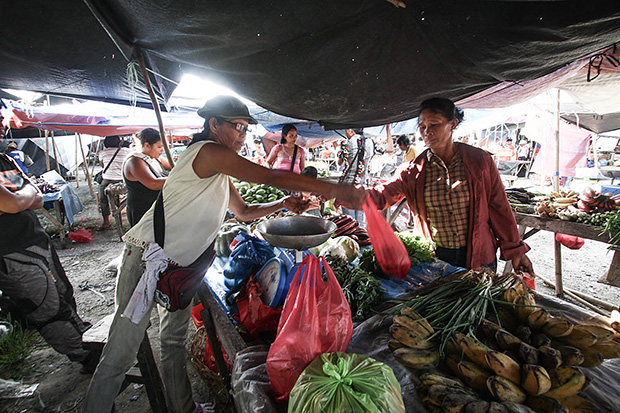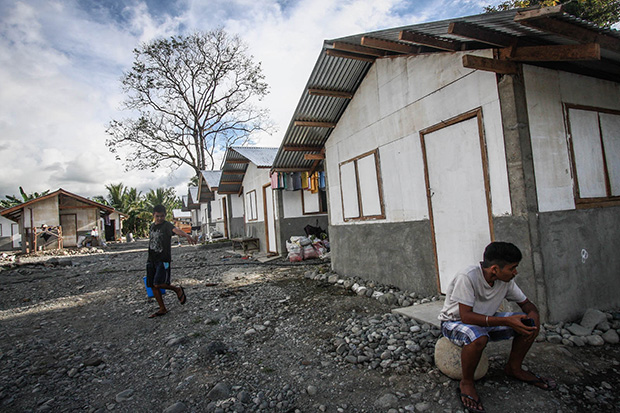NEW BATAAN, Compostela Valley (MindaNews/05 Dec.) – Wednesdays mean “tabo,” a market day in this sleepy town.
But on December 5 last year, which was a Wednesday, a tabo never happened.
 Vegetable vendor Melodiya Dagandan at her stall in the market of New Bataan, Compostela Valley province on December 4, 2013. MindaNews Photo by Ruby Thursday More
Vegetable vendor Melodiya Dagandan at her stall in the market of New Bataan, Compostela Valley province on December 4, 2013. MindaNews Photo by Ruby Thursday More
It was the day after typhoon Pablo struck, leaving at least 430 persons dead and at least 320 others missing to this day.
On Dec. 5 last year, the residents were frantically looking for family members, relatives and friends who were either buried or swept by rampaging debris in a flashflood spawned by Pablo.
The flashflood, which almost wiped out Barangay Andap, reached the town proper and washed away houses and stalls in the market.
A knee-deep mud covered a huge part of the market area and made it difficult for rescuers and villagers to search for villagers who may have been buried beneath.
On Wednesday, Dec. 4, some 2,000 people gathered for a commemorative mass held at the San Roque chapel in Andap, the hardest hit village, where a massive debris flow that included giant boulders almost flattened the entire area.
The chapel had undergone a major facelift. Its damaged façade had been replaced with a pile of stones. Its ceiling had been replaced too except for a piece of plywood on the right side of the altar.
This part of the ceiling had two holes through which the villagers passed to get to the roof during the flood.
Parish priest Edgar Tuling said they preserved the damaged ceiling to serve as a reminder of the disaster.
Dozens of villagers sought refuge in the chapel when the flood came. It was spared from the debris flow even as waist-deep mud, rocks and fallen coconut trunks had piled up in front.
The chapel serves as the most significant surviving landmark of the village.
In the town’s market place however a tabo was going on even as a rite of remembrance was being held in the chapel for those who perished in the flashflood a year ago.
Vegetable vendor Deborah Josol told MindaNews it took them over a month to reopen their stall because their farm in Andap was washed away.
Josol, in her mid-20s, added that a month after the disaster most of the vendors in this town were getting vegetables from Tagum City and nearby towns.
“Besides, only a few residents would come to the market at that time,” she said referring to the whole month of December last year.
But for Melodiya Dagandan, it took her six months to reopen her stall.
Dagandan said they lost all their vegetable seedlings and it was hard to replant even if their farm was spared from the flashflood.
“Our farm is located in the mountain but its (Pablo) strong winds left mountains almost barren,” she said.
Most of the vegetable farmers in Andap had planted again after getting seedlings from the Department of Agriculture early this year, she added.
 The relocation shelters provided by thePhilippine Red Cross for the survivors of typhoon Pablo in New Bataan, Compostela Valley. Mindanews Photo by Ruby Thursday More
The relocation shelters provided by thePhilippine Red Cross for the survivors of typhoon Pablo in New Bataan, Compostela Valley. Mindanews Photo by Ruby Thursday More
Relocation sites
According to the National Disaster Risk Reduction Management Council, 36,248 persons had been affected by the typhoon in this town.
Four relocation sites had been built for the displaced families.
Jose de Rosa, a carpenter from Purok 1, said his family sought refuge in the grandstand of the sports complex when the flood hit.
A month later, they moved to the makeshift tents provided by the Philippine Red Cross inside the school compound.
“I worked as a carpenter when the relocation shelters funded by the provincial government of Pampanga were built,” de Rosa added.
Fifty-six other families are now living too in the relocation shelters built by the PRC.
But de Rosa said that sometimes heavy rains would cause flooding in some parts of the relocation sites.
MindaNews saw some shallow canals that had been carved around some houses to prevent the water from going inside.
De Rosa, who has worked in different construction sites in other towns, added that the ground level in their relocation site is uneven and this may have caused the flooding.
He noted that other houses were built on higher elevations.
The houses were made of hollow blocks, coconut lumber, plywood walls, concrete floor and iron sheets as roofing.
A mother, in her 50s, said heavy rains had caused the flooding in the relocation center.
Traces of destruction
A year after the tragedy, the traces of destruction were still evident in many parts of this town.
The tattered roof sheets of the bus terminal and some market stalls had remained in place.
In Purok 4 of the town proper, vegetation had concealed the depressing view of rocks and boulders.
The rocks and boulders went with the debris flow when Mayo River changed its course and washed away this former residential area.
In Purok 1, Nida Calibugan said she was able to reopen her eatery business six months after the flashflood hit.
Calibugan said the mud and water did not totally destroy their eatery but carried away their belongings including dozens of cooking pots and utensils.
Purok 1 one covers the market area and it was where many of the corpses from as far as Andap were recovered.
Andap is about seven kilometers away from the Purok 1. (Keith Bacongco/ MindaNews)
